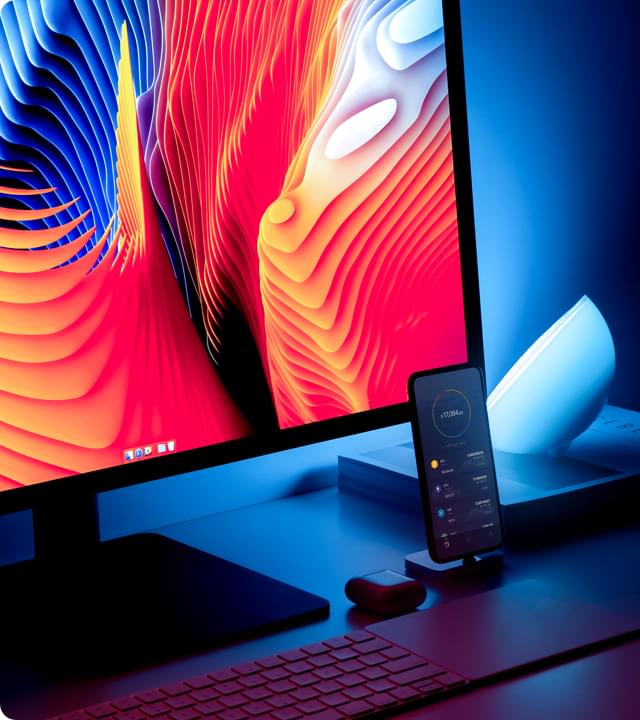Bitcoin: be your own bank!
That’s a compelling catchphrase but being your own bank also means that it’s the investor’s responsibility to keep his or her coins safe. If someone accesses your wallet and steals your crypto it’s gone for good. Transactions cannot be reversed and accounts cannot be frozen. That’s why security is so important.
In this article we’ll consider a few of the safest ways to store your Bitcoin. We’ll focus on cold storage, however, first we have to define another term: hot storage (hot wallet).
What's a Hot Wallet?
A hot wallet is a cryptocurrency wallet that’s connected to the internet. These can be web wallets (wallets accessed through a web browser) or software wallets.
MetaMask is a popular Ethereum wallet that works as a web browser extension. Exodus is a software wallet that is also a hot wallet since it connects to the internet. If you have Exodus installed on your computer or phone, you are using a hot wallet.
Software wallets are generally more secure than web wallets but still rely on basic computer and internet security practices.
The main advantage of a hot wallet is convenience. You can easily add the MetaMask extension to a Chrome browser and interact with the DeFi ecosystem built on top of Ethereum, including decentralized exchanges, yield aggregators and all sorts of other interesting decentralized applications.
While it’s very convenient, a hot wallet is that it’s not the most secure method of storing Bitcoin. It places a higher burden of security on the user to keep their computer or phone free of viruses and malware. If a users computer is hacked, any funds held on that computer are at risk. While cold wallets are immune to malware and viruses, they require a bit more time to set up, which can prove to be an inconvenience to some.
A hot wallet = convenience > security.
A cold wallet is the opposite = security > convenience.
*In this article we’ll use the terms cold storage and cold wallet interchangeably, they mean the same thing.
Bitcoin Cold Storage
Cold storage indicates that a wallet is kept offline, there is no connection to the internet and no opportunity for a hacker to gain access to your Bitcoin. A cold wallet is less convenient than a hot wallet but it’s much more secure. Provided that an investor follows the proper procedure in setting up a cold wallet, there is virtually no chance of a hack.
For example, it’s likely that Coinbase is the largest holder of cryptocurrency in the world. That makes Coinbase the crypto ecosystem’s biggest honey pot. Even making off with just 1% of all the crypto that Coinbase controls would be a tremendous windfall. Well aware of the risks, Coinbase keeps its crypto in cold storage.
In the next two sections, we’ll look at two of the most popular cold storage methods that you can use to keep your Bitcoin safe.
Cold Storage Method 1: Bitcoin Hardware Wallet
A hardware wallet is considered cold storage because it’s physically disconnected from the internet. Once you send your Bitcoin to a hardware wallet address, the only way to retrieve the coins is to plug the device into your computer.
Otherwise, you can just keep your hardware wallet in your drawer, disconnected from your computer, and nobody can access your crypto. You can send Bitcoin to your hardware wallet when it’s not plugged in, but you can’t send coins off the device unless it’s plugged in.
Even when you connect your hardware wallet to your computer there is another level of redundancy: the only way to send Bitcoin out of a hardware wallet is to press a physical button on the device.
In terms of safety, what this means is that even if a hacker tries to send a fraudulent transaction, so long as you don’t press a button on the device the Bitcoin will never leave your wallet.
This is why it’s possible to plug a hardware wallet into a computer that’s heavily infected with malware and viruses. A virus could attempt to initiate a transaction, however, if the user doesn’t approve the transaction by pushing the button the coins will remain safe.
Your hardware wallet is only safe if you do this…
Although we just praised hardware wallets for being ultra-secure, that security depends on one thing: keeping your seed phrase safe.
When you “initiate” a hardware wallet for the first time it will give you a seed phrase. The seed phrase is typically 12 words, although it could also be 24 words.
This random list of words is used to generate the private key for your hardware wallet and it’s crucial to keep this seed phrase safe. The seed phrase can be used to take control of a cryptocurrency wallet from anywhere in the world.
- Never, never, never store a seed phrase in a text document on your computer or in an email. If a hacker gains access to your files or email he may find the seed phrase
- Never take a picture of the seed phrase. Remember when hackers were able to gain access to sensitive photos stored on Apple servers?
When dealing with seed phrases the best thing is to go old school. Write down your seed phrase by hand and make one or two copies by hand. Keep one copy at home and another copy at a different location. You don’t want to be in a situation where a fire or a flood can destroy all copies of the seed phrase at the same time.
What happens if I lose my hardware wallet?
Since hardware wallets are password (pin) protected they are actually quite secure. If you realize that you’ve lost your hardware wallet you can buy a new one and use the seed phrase to recover your funds. Once you’ve recovered your funds you should create a new wallet with a new seed phrase and transfer all of your crypto to this new wallet.
To reiterate, if your hardware wallet is stolen there is a low likelihood that anyone will be able to gain access to your crypto before you can retrieve the funds.
However, if someone gains access to your seed phrase they can steal all of your crypto within minutes. This is why it’s so important to store your seed phrase securely.
Finally, never give your seed phrase to anyone. Never, ever enter your seed phrase into a website, no matter how authentic the website looks. There are very sophisticated phishing scams targeting hardware wallet users and investors should remain vigilant lest they end up like this.
The Trezor Wallet
There are a couple of different hardware wallets out there, the two most popular devices being the Ledger and the Trezor. We’ve already written an article comparing these two devices: Trezor vs. Ledger: What to Buy and Why.
The Trezor wallet can integrate directly with Exodus so that you can easily keep your Bitcoin safe. You can also use a Trezor hardware wallet on Exodus with a bunch of other coins as well. A full list of supported cryptocurrencies is available here.

Cold Storage Method 2: Bitcoin Paper Wallet
A Bitcoin paper wallet is the second most popular form of cold storage. The advantage of a paper wallet is that it’s free, however, the downside is that it’s less convenient than a hardware wallet. Here’s how it works.
- A Bitcoin hodler creates a BTC wallet on an air gapped computer (a computer that isn’t connected to the internet).
- Once they’ve created the wallet the hodler can generate an address, export that address to a USB drive and then plug the USB drive into a normal computer
At this point the investor can send funds to the Bitcoin wallet that’s on the air gapped computer. Since the wallet is offline it’s considered a cold storage solution. Bitcoin can be safely sent to the wallet, even though it’s not connected to the internet.
The problem is that sending coins out of the wallet is difficult. You have to either connect the air gapped computer to the internet, or go through a complex process of signing a transaction using the USB drive.
For this reason, a paper wallet generated on an air gapped computer is only a good solution for someone who is technically sophisticated and doesn’t want to access their coins very often.
For most investors, a hardware wallet is a better option. Most hardware wallets cost less than $100 and it’s important to point out, the cheaper models are not less secure. Expensive hardware wallets typically only cost more because they have advanced features like a large screen or Bluetooth compatibility.
Security Trumps Everything
If you’re going to invest in Bitcoin the most important thing you can do is store your coins securely. A good rule of thumb is that if you have crypto that’s worth more than the cost of a hardware wallet, you should probably buy that hardware wallet. Or if you feel comfortable using Bitcoin, you can create a paper wallet on an air gapped computer.
Whatever you do, don’t keep your Bitcoin on an exchange! Exchanges get hacked, they get prosecuted and shut down, accounts get frozen and some exchanges even turn out to be insolvent. It’s a jungle out there and if you keep your coins on an exchange, right when you need your Bitcoin the most it could be unavailable.
If you have a Trezor hardware wallet you can use it directly with Exodus. Or if you have a Ledger you can use the Ledger Live crypto wallet to access the coins on the device.
This content is for informational purposes only and is not investment advice. You should consult a qualified licensed advisor before engaging in any transaction.





